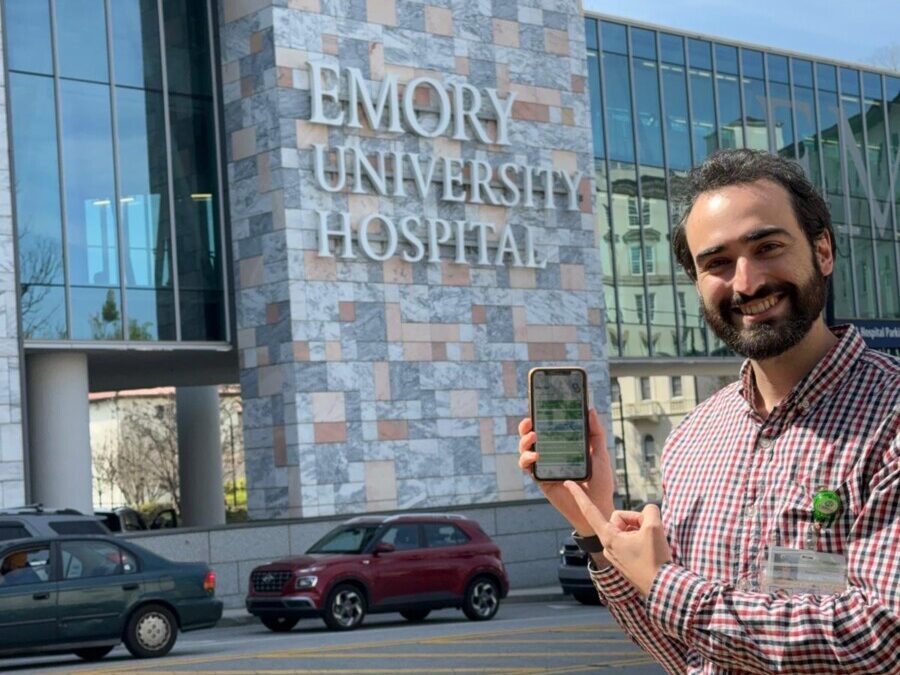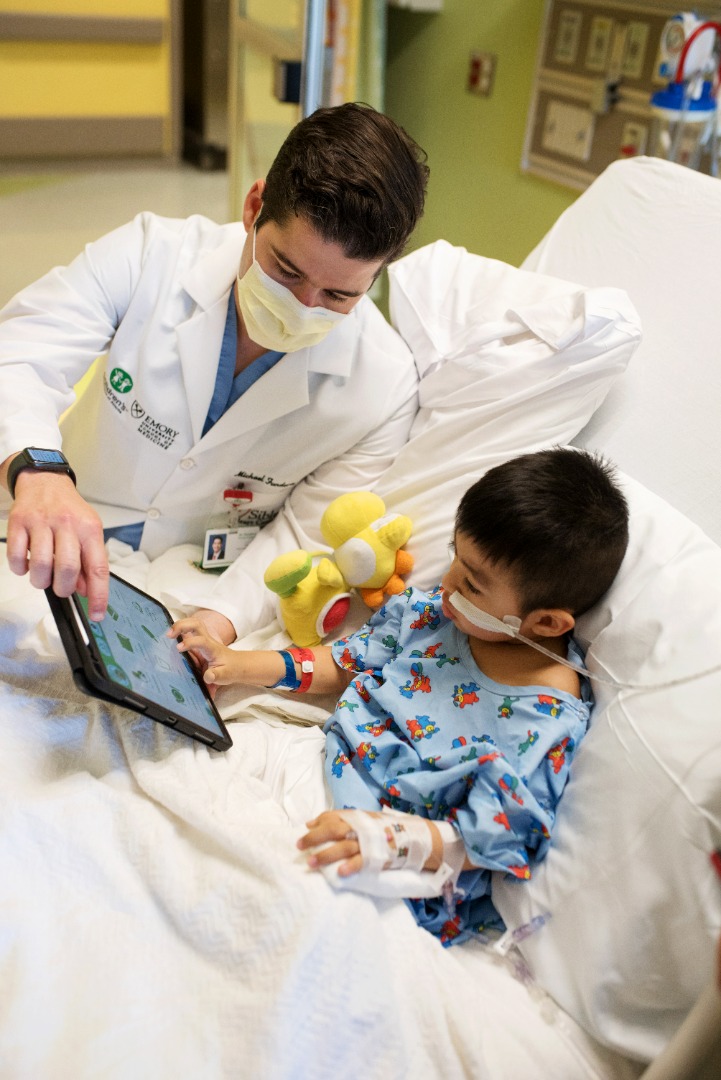Santiago Arconada Alvarez is one of five members of the team receiving the Inclusivity, Diversity, and Equity Award (IDEAward). Their technology, Low English Proficiency Nurse Communication Tool, is an application that revolutionizes how nurses communicate with patients who have limited English language proficiency and their caregivers. This novel mobile app enables the clinical team to communicate using common phrases in the patient’s language, images, and real-time translation.
Can you introduce yourself?
I am Santiago Arconada Alvarez and I’m a product development team lead working on medical apps for clinical research. Currently, I co-lead a group called the AppHatchery at Emory University.

Santiago Arconada Alvarez shows off the nurse communication app outside Emory University Hospital.
We are a multidisciplinary group funded by Georgia CTSA that supports the translation of science, which brings research from labs to clinical settings for the public to access the benefits of basic research. Our particular group focuses on the creation of software, specifically the user-centered design process. Our goal is not only to implement the ideas on a technical level but also to try to understand the base of a project for better user experiences.
What did you enjoy about winning an award?
This project really resonates with me on a personal level, as I’m not native to the U.S. and thus foreign to its healthcare system. It still gets stressful walking into the hospital even after being here for a long time, and I’ve observed the same through other people’s experiences. For me, I’m just so happy that Emory awarded us and recognized this issue as well as our efforts to address it with the tool that we built. It feels like our passion and work in this field are recognized by OTT, which really makes us want to work more.
Can you tell us a little bit more about the technology/innovation you received the award for?
Christina [Calamaro, PhD] first approached us with the idea of creating a tool to facilitate communication between nurses and patients who have limited English proficiency. The first step we took was trying to understand the issue firsthand and through various angles before building anything. We did observations and interviews with nurses to understand the hospital ecosystems and then started to build the app that helps nurses communicate with non-English speaking patients for simple things. There have been similar technologies or approaches such as human or video interpreters. However, they are not convenient to use, as there can be issues such as time lags during live interpretation, speaker hurdles, or misinterpretation. That is where our tool came in place.
Temporarily named ‘Leap,’ this app doesn’t serve as an interpreter. Instead, it is an added tool for nurses to convey their meanings in simple phrases. For instance, a family came into the pediatrics department and the nurses wanted to check their vitals. The family can get nervous and confused, not understanding what the nurses are saying. With our tool, such simple communication can be done without human interpreters or video technology.

Michael Fundora, MD, one of the creators of the limited language nurse communication tool, uses the app with a pediatric patient.
More specifically, this app can be loaded on nurses’ phones, where they can choose from several card lists consisting of frequently used phrases. These phrases can be conversational, nursing-task related, or simple questions, which are optimized based on nurses’ experiences and needs from their interactions with patients. In addition, it includes a live translator feature that helps translate patients’ conversational questions.
What does this award mean for your group or your family?
For our group, this is one of the first technologies we’ve built over the last four years that’s very close to getting commercialized. For us, as an innovation group, it’s very exciting to see our technology leaving Emory and potentially seeing it in the field and around the US. There is no more joy and pride than seeing thousands of people use our invention. For me personally, I just really see a need for people to feel more taken care of. This technology enables healthcare providers to communicate and actually connect with their patients on a more personal level. Hopefully, this effort will help increase health equity in the hospitals and add a small piece to a bigger conversation.
What are the next steps for this technology?
We’ve done pilot studies with the prototype, iterating and making changes according to feedback. Currently, this is probably the most exciting time for us as we are launching this app at a hospital level, where the entire hospital will have it installed on their phones.
The next step will be to assess if the app will work. If it works, we will try to see how we can make it better and expand the tool to other places. If it doesn’t, we will try to address the limitations and people’s experiences. As a product-driven innovation team, it is important for us to understand who the technology is working well for, and who isn’t, and such feedback will fuel our innovation and make the product better. We would also love to deploy the app to the Emory Healthcare system and expand its uses to adult patients, as it was previously designed for pediatrics. It would also be awesome if we could bring this technology to other areas with similar needs.
Do you have one word to describe your feeling of winning this award?
Recognized.
Join us for Emory OTT’s 18th Annual Celebration of Technology and Innovation on Thursday, March 21! RSVP here.
– Samme Xie